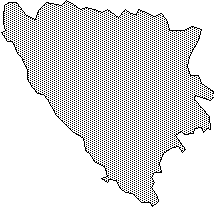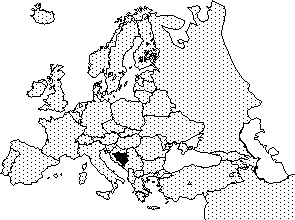[Front page] [Contents] [Previous] [Next] |
Management of Contaminated Sites and Land in Central and Eastern Europe
Bosnia-Herzegovina
Country Characterisation


Background
Bosnia-Herzegovina generally belongs to a mountainous region (700 m and above).
Due to irrational utilisation of soil, particularly within agriculture and forestry, there is a continuous damage of soil surfaces. Land devastation is caused by contamination, degradation and destruction.
According to approximate data 3000 km2 of land is contaminated, and 10000 km2 is in the process of degradation. Physical destruction of land covers about 500 km2. The annual loss of land is about 30 km2 primarily due to expansion of settlements and sites with excavation of raw materials. During the four years of war approximately 60 km2 of land have been damaged, and following the war 12000 km2 have to be considered as mine fields.
Total area |
Agricultural areas |
Wooded areas |
Nationally protected areas |
Mountain terrain |
||||
km2 |
km2 |
% |
km2 |
% |
km2 |
% |
km2 |
% |
51197 |
25250 |
49 |
23310 |
46 |
2570 |
5 |
||
| Figure on total area from UN/ECE, 1998. | ||||||||
Population |
Population density |
Annual pop. growth |
Life expectancy at birth Male Female |
|||||
1000 |
per km2 |
% |
years |
years |
||||
| 3738 | 73 | -4,37 | - | - | ||||
| Figures from UN/ECE, 1998, and POPIN, 1999. | ||||||||
Legal and Administrative Basis
Definition of Contaminated Sites and Land
There is no specific definition for contaminated sites and land.
Legislation
Generally, soil and groundwater issues are regulated by the following laws:
| The physical planning law. | |
| The environmental protection law (in preparation). | |
| The agricultural land law. | |
| The law on waters. | |
| The law on forests. | |
| The geological law. | |
| The nature protection law. |
Implementation of Limit Values
The implementation of limit values is very small.
Responsible Public Authorities
Institutions responsible for management of soil and groundwater contamination are:
| The Federal Ministry of Physical Planning and Environment. | |
| The Federal Ministry of Agriculture, Water Management and Forestry. | |
| The Institute of Agropedology. | |
| The University of Sarajevo (Faculty of Forestry and Faculty of Agriculture). |
Registration
Maps have been prepared for areas in the vicinity of industrial zones showing areas with contaminated soil. However, it is necessary to continue investigation work that was performed before the war.
Also maps showing erosion areas must be improved, as some of the consequences of the war are accelerated soil erosion. It is urgent to establish remediation programmes for these areas as the pose a major risk for residents and land.
Furthermore, it is necessary to establish programmes for the rehabilitation of devastated areas (mine fields, industrial waste depots, military installations etc.).
Characterisation of Soil and Groundwater Contamination
Sources of Soil and Groundwater Contamination
Soil has been contaminated in areas of some industrial and urban regions (e.g. Zenica, Tuzla, Kakanj, Sarajevo etc.). Here, the soil is contaminated with heavy metals e.g. Pb, Zn, Mn, Co, Cu, Mb and Cd. High contents of sulphur have been found especially in areas of power plants (Kakanj and Lukavac).
A particular problem in Bosnia-Herzegovina is dumpsites for ash and slag from power plants as well as waste (red mud) form aluminium industry. The ash causes great ecological problems.
Besides the above-mentioned, the agriculture and forestry also cause soil contamination. However, the use of fertiliser in Bosnia-Herzegovina is rather small in average about 55 kg/ha.
Generally, soil contamination is caused by heavy metals, sulphur compounds, organic pollutants, acid rain, fertiliser, pesticides, ash depots and red mud.
Besides contamination there is also a physical destruction of land. The causes of land destruction are divided into two groups (temporary and permanent), and considered through 3 periods:
| Pre-war period up to 1992. | |
| War period 1992 – 1995. | |
| Post-war period from 1995. |
Temporary physical destruction of land in the pre-war period was caused by surface mines, gravel pits, clay pits, industrial waste depots, and erosion. As land damage causes was considered as residential areas, industry, roads, and airports. The estimated land loss was about 3000 ha per year.
Besides the suffering of citizens and the destruction of economy during the four years or war, specific land damages also occurred. Causes of land destruction during the war were damages from explosion of mines and shells, trenches and embankments, concrete fortifications, temporary roads, temporary settlements, mine fields, accelerated erosion, moving of military troops across agricultural areas and poison gases. Approximate land losses during the war was about 6000 ha, with the major par characterised as temporary damages. Particular heavy losses were on areas where trees were cut down. The consequence of this is acceleration of soil erosion.
Causes of land damages in the post-war period are the same as in the pre-war period supplemented by accelerated building of settlements, felling of trees and soil erosion as well as remaining mine fields. Also, use of land on hillsides has been intensified providing for accelerated soil erosion. De-mining activities are performed slowly. Existing mines present a major danger for citizens, and also limit the use of the areas in agricultural production.
Number of Registered Contaminated Sites / Contaminated Land Areas
So far, the number of registered contaminated sites is 6.
Investigation Methods
Identification of Potentially Contaminated Sites and Areas
Identification of potentially contaminated sites and areas is based mainly on areas near highways. These investigations are carried out in the community of Sarajevo.
Also, identification is carried out in the urban zones, and included here are the urban zones of Sarajevo and Tuzla. Furthermore, identification is carried out in the industrial zones, and included here are Tuzla and Zenica.
Investigation of Contaminated Sites and Areas
Investigations of soil contamination have been performed in areas of some industrial zones as well as some urban zones (Sarajevo).
Also, investigation activities have included soil sampling at various sites depending on land use as arable land, meadows and pastures. Mainly, samples have been collected from two depths as surface and subsurface layers.
Facilities for Contaminated Soil
Handling and Treatment of Excavated Contaminated Soil
Up till now, no facilities exist for treatment of proper depositing of contaminated soil.
Measures Used by Remediation of Soil and Groundwater Contamination
Up till now, no measures have been used for remediation of contaminated soil or groundwater.
Otherwise, remediation is based on given recommendations as e.g. the use of lime for acid soils, and choice of proper cultures for that can grow on contaminated sites.
Financing and Liability
Investigation and Remediation Activities
No data available
Legal Requirements re. Polluters and Site Owners
Legal requirements demand that polluters pay for remediation of damages caused to the soil. This provided for special laws and decisions. However, up till now there is no significant application of these requirements.
Scope of the Problem
Scale of the Problem and Handling Costs
The highest costs refer to the recultivation of damaged soils.
Priority in Relation to Other Societal Problems
Up to date, revitalisation of devastated areas has been very limited. For this reason, only small area have been reclaimed (about 10% of the total devastated area).
Illustrative Cases
No data available
References
Information provided by Mladen Rudez at the Federal Ministry of Physical Planning and Environment of Bosnia and Herzegovina. April 8, 1999.
Ad Hoc International Working Group on Contaminated Land (1998). Ad Hoc CEE Forum on Contaminated Land. Report of the Warsaw Meeting, September 18, 1998. Report from the Swiss Agency for the Environment, Forests and Landscape.
POPIN (Population Information Network) (1999). The Demography of Countries with Economies in Transition. At gopher://gopher.undp.org/00/ungophers/popin/wdtrends.
UN/ECE Statistical Division (1998). Trends in Europe and North America. 1998 Statistical Yearbook of the UN/ECE. At http://www.unece.org/stats/trend/trend_h.htm. Based on figures from 1994 – 1997.
[Front page] [Contents] [Previous] [Next] [Top] |